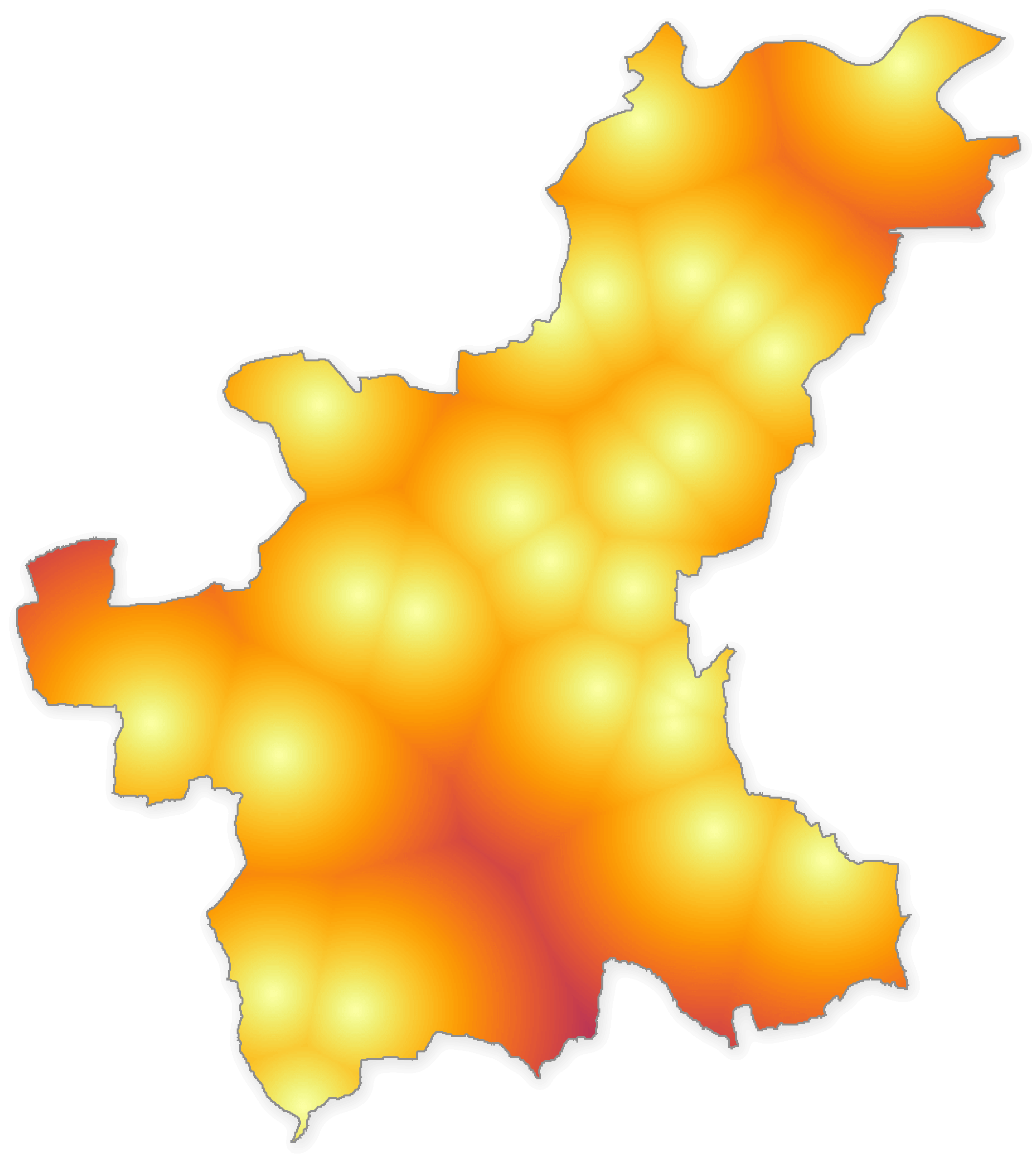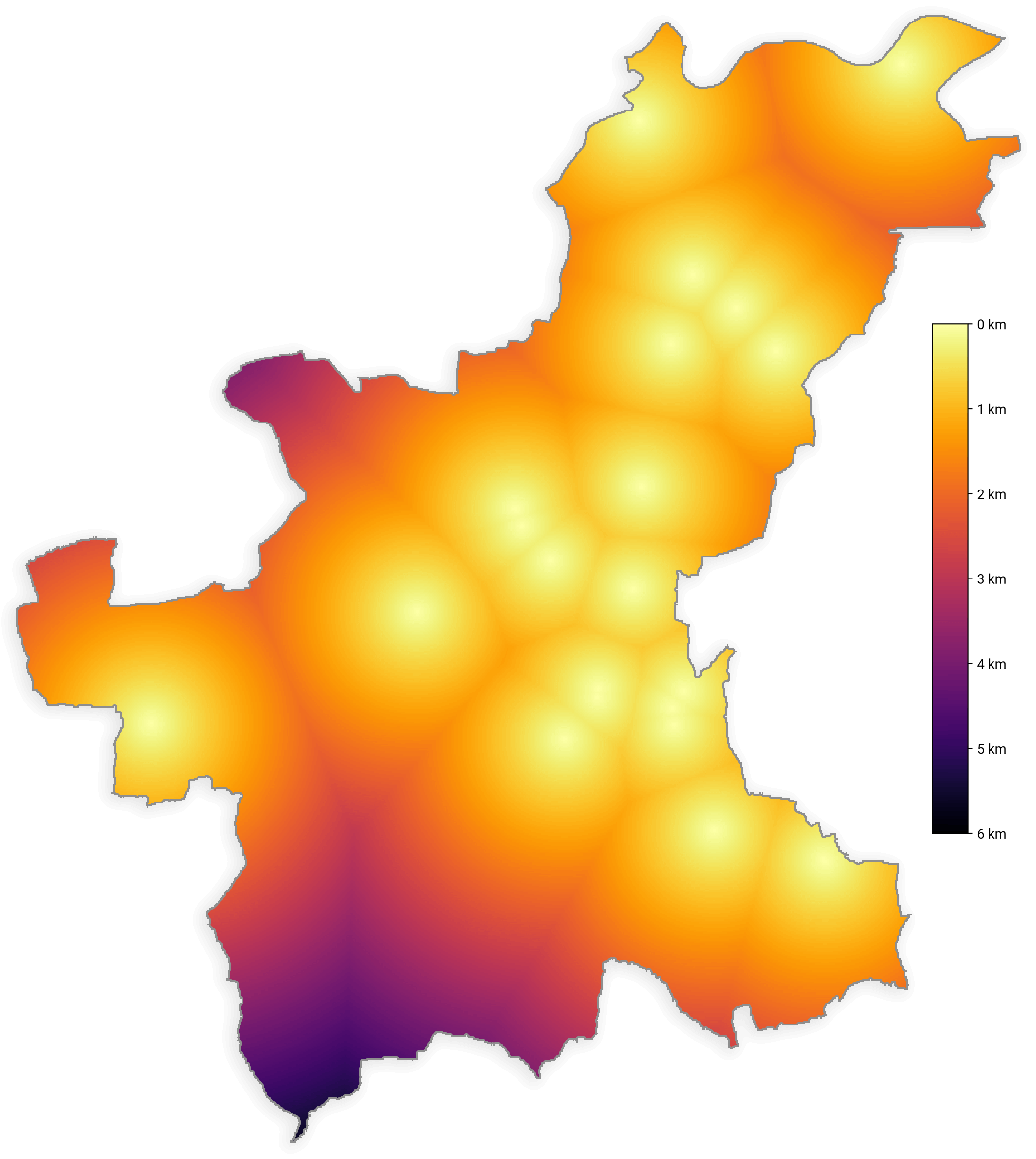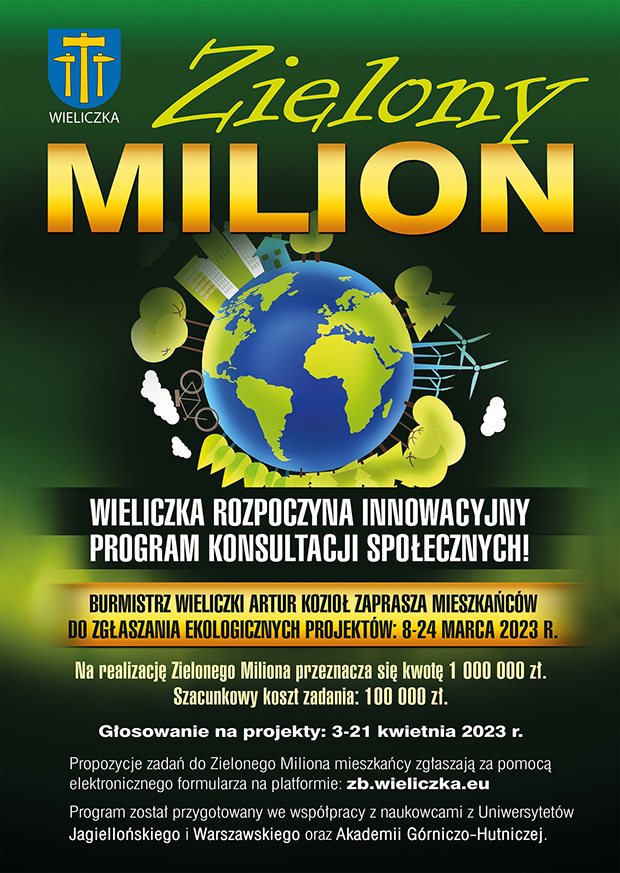Wieliczka Zielony Milion ("Green Million") 2023
Summary: This page presents the results of the participatory budgeting election of the Green Million campaign, conducted in Wieliczka in 2023. Since this is the first use of the Method of Equal Shares, we also present the results of an analysis comparing the new method with the one most commonly used in other cities. The results of this analysis are very positive and show that, thanks to the Method of Equal Shares, the percentage of voters who had no influence on the election outcome has been significantly reduced, and we have avoided excluding projects from the southern part of the municipality.
| Key facts | |
|---|---|
| City | Wieliczka, Poland (wikipedia, maps) |
| Official website | https://zb.wieliczka.eu/budzet-obywatelski |
| Date of election | 2023-04-26 |
| Budget | PLN 1 000 000 |
| Number of voters | 6586 |
| Number of projects on the ballot | 64 |
| Number of winning projects | 30 |
| Special feature | Projects about ecology and the environment |
| Voting rule | Method of Equal Shares |
| Voting input format | Approval vote (no maximum number) |
| Voting rule details | "Add1" completion, comparison step |
Scientific team involved in developing the results: Jarosław Flis, Piotr Faliszewski, Dominik Peters, Grzegorz Pierczyński, Piotr Skowron, and Stanisław Szufa.
Publication date: 2023-04-26.
Election Results
6586 residents participated in the election. A total of 1 million zł (PLN, Polish złoty, approximately EUR 220 000) was allocated to the participatory budget. Thus, each voter was allocated a budget of around 151 zł. Due to the nature of the method (as described in detail on another page), this amount increased to 313 zł. In other words, each group of 100 voters could decide on a project with a cost of up to 31 300 zł. Out of the submitted projects, 64 were admitted by the municipality and placed on the ballot, of which 30 were selected for implementation. The total cost of the selected projects is 995 079 zł.
Below we present a list of submitted projects. Projects selected for implementation have been marked in green. For each project, we provide its cost and the number of votes it received. The size of the horizontal bars is proportional to the cost and the number of votes, respectively. In addition, for each project, we provide its effective support, which is a percentage value describing to what extent the support size exceeds the threshold required for project acceptance: a value above 100% means that the project was selected, and a value below 100% means that the project was not selected. For example, an effective support value of 60% means that the project received 60% of the votes required for acceptance.
Projects may not have been selected for one of the following reasons:
- the project received too few votes compared to its cost, or
- voters who voted for a given project also voted for other more popular projects, so their votes were primarily used to fund these more popular projects.
There is also a technical report (PDF) which allows for verification of the process of calculating the winning projects.
Frequently Asked Questions
How does the Method of Equal Shares work?
It virtually assigns each voter an equal share of the budget. In this case, each voter is allocated 313 zł. The Method of Equal Shares then selects the most popular projects, but only if they can be funded with the virtual funds allocated to the supporters of such projects. If a project's supporters do not have enough funds to pay for it, the project will be skipped. Thus, if a project costs 100,000 zł, it must receive at least 320 votes to have a chance of being funded. Of course, such a project must also receive more votes than other projects to win.
A more detailed description of the method can be found on this page.
What are the main benefits of using the Method of Equal Shares?
It gives each voter an equal influence on the voting outcome. This leads to fairer results than using the standard voting method (which just selects projects in order of vote count). Below are diagrams illustrating the advantage of the Method of Equal Shares. In particular, we see that more voters get at least one project among those they voted for. Moreover, the winning projects are more evenly distributed in the municipality.
Why was project no. 21 ("Construction of an educational-ecological path in Laskowiec in Pawlikowice") not selected?
It was not selected because many votes cast for project no. 21 were used to fund the more popular project no. 6 ("Green Flag - revitalization of green areas with plantings").
More details: Projects no. 24, 41, 40, 74, 19, and 6 received more votes than project no. 21, so they were selected earlier. 43% of those who voted for project no. 21 also voted for project no. 6 and contributed 40,000 zł of their allocated funds to it. Voters supporting project no. 21 also used a total of 22,700 zł to fund projects no. 24, 41, 40, 74, and 19. After using these funds, only 93,900 zł remained for the voters who supported project no. 21, which was not enough to cover the cost of project no. 21 at 100,000 zł.
Why was project no. 16 ("Green Mi(lion)etniów - green lesson") not selected?
It was not selected because many votes cast for project no. 16 were used to fund projects no. 6 ("Green Flag - revitalization of green areas with plantings") (this project was more popular than project no. 16) and project no. 70 ("'I grow in summer, autumn, and spring' - creating a flowering meadow on the square between the J. Latuska Municipal Kindergarten in Mietniów and the community center in Mietniów") (this project was cheaper than project no. 16, so it obtained a higher effective number of votes). However, the result was very close, and project no. 16 was close to winning (it had effective support at the level of 99%).
More details: Among the voters who voted for project no. 16, 52% also voted for project no. 6, and 64% for project no. 70. These voters contributed 38,700 zł of their allocated funds to project no. 6 and 11,800 zł to project no. 70. These voters also contributed a total of 17,000 zł to other more popular projects. After using these funds, only 49,998 zł remained for the voters who supported project no. 16, which was not enough to cover the cost of project no. 16 at 50,000 zł.
Why was project no. 87 ("Revitalization of a green square into an eco-playground and recreation area in Śledziejowice") not selected?
It did not receive enough votes. Project no. 87 cost 74,000 zł. It received votes from 292 voters, who were collectively allocated approximately 92,000 zł. Although initially, this was enough to cover the cost of project no. 87, after selecting the 6 most popular projects, these 292 voters used about 18,700 zł of their allocated funds (this is because some of these voters also voted for some of these more popular projects). Thus, only 73,300 zł remained for the voters who supported project no. 87, which was not enough to cover the cost of project no. 87 at 74,000 zł.
Project no. 8 (Green Corner in the Market) was not selected for similar reasons.
Comparison of the Method of Equal Shares with the standard voting method
Since this is the first year that Wieliczka uses the Method of Equal Shares, a natural question arises about how it compares to the "standard voting method", which simply selects the projects with the highest vote counts until the budget is exhausted. This voting method is the most commonly used method in participatory budgeting. We conducted an analysis comparing the election results for these two methods. The results of this analysis clearly indicate the benefits of using the Method of Equal Shares:
Fewer excluded voters. Using the Method of Equal Shares, 18% of voters did not receive any of the projects they voted for. If the standard voting method were used, this percentage would be as high as 28%. This means that thanks to the Method of Equal Shares, it has been possible to significantly limit the percentage of voters who had no real influence on the outcome of the elections. Moreover, most of these voters who did not receive any projects voted for only one project, so their preferences could not always be taken into account. Among voters who voted for at least two projects, the percentage of those who did not receive any projects is only 9% (with the standard voting method, it would be 15%).
- Higher average voter satisfaction. For the average voter, 1.61 projects of the projects that the voter voted for were selected. For the standard voting method, it would be 1.47, so the Method of Equal Shares allowed for a 10% improvement.
- More votes are translated into the voting result. The standard voting method selects 4 projects that the Method of Equal Shares does not select. These 4 projects together received 1453 votes. With the money saves, the Method of Equal Shares selects 11 other projects, which together received 2414 votes.
No regional bias. Based on GPS coordinates, we marked projects on the map of Wieliczka that were selected using the Method of Equal Shares (blue map on the left) and which would be selected using the standard voting method (red map on the right). The size of the circles marked on the map corresponds to the cost of the selected projects. If the standard voting method were used, the southern part of the municipality would be left without projects. Thanks to the Method of Equal Shares, we see a more even distribution of projects; in particular, we see that the residents of Byszyce and Gorzków and the western part of the municipality were not excluded from the decision-making process, which would be the case if the standard voting method were used.
Better distribution of voter satisfaction. The chart below shows the distribution of voter satisfaction. For example, with the Method of Equal Shares, 45% of voters received one project from among those they voted for, and 21.2% of voters received two projects. We see that with the Method of Equal Shares, the distribution of satisfaction is more even, meaning we have more voters who received at least one or at least two projects from among those they voted for. Moreover, if we look at the amount each voter decided, the standard deviation of these values decreased by 18% compared to the standard voting method.
Projects of different sizes have equal chances of winning. Compared to the standard voting method, the Method of Equal Shares does not select several of the most expensive projects. This allows funding several popular smaller projects. For applicants, this means that it is worthwhile to submit smaller, more local initiatives as well as larger, more ambitious projects.
Below, for each point on the map, we show the distance from the nearest realized project. Darker points indicate that there is no realized project near a given location. Again, we see that the standard voting method would exclude parts of the city, while the diagram for the Method of Equal Shares is bright, and thus the selected projects are more evenly distributed throughout the municipality. In particular, in the case of the Method of Equal Shares, for each resident of the municipality, their distance from the nearest realized project is no more than 3.4 km; in the case of the standard voting method, this value would be as much as 6.1 km.


Voting statistics
Below, we present a chart showing how many projects voters voted for. (Voters were allowed to vote for as many projects as they wanted, and some of the voters in fact voted for all 64 projects on the ballot.) For example, 3328 voters voted for just one project, 1456 voted for 2 projects, and so on.
External links (in Polish)
- Official results page
- YouTube: Announcement of results [12:25 min] (2023-04-26)
- Rzeczpospolita (newspage): "Are we facing a revolution in participatory budgeting?" (2023-04-28)
